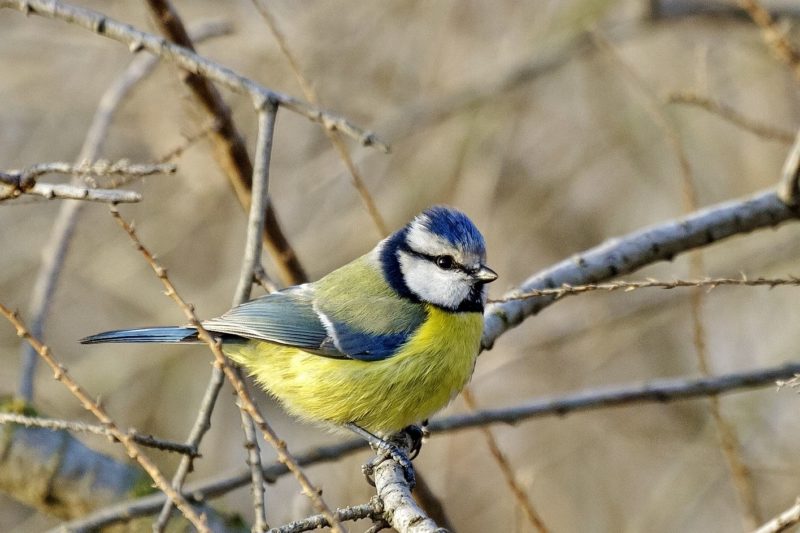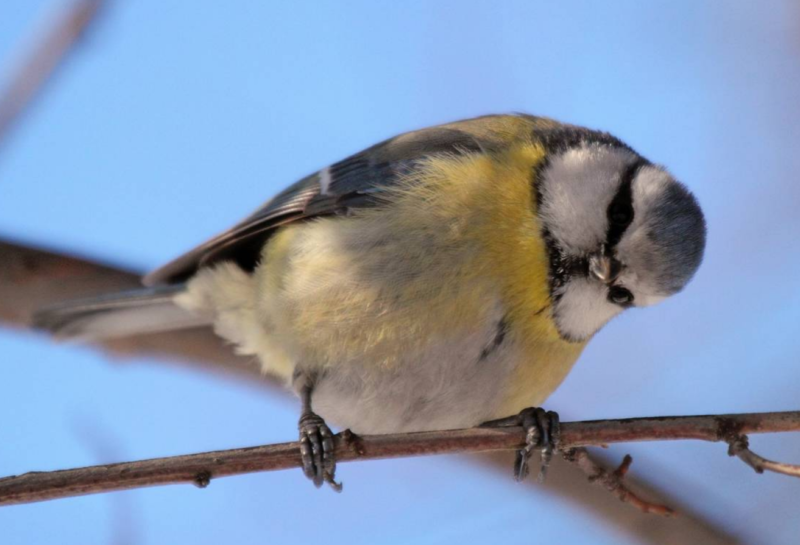The cheerful, unpretentious singing of this bird in winter, like the ringing of a bell, reminds of the imminent arrival of the long-awaited spring. The common blue tit is the azure blue heritage of Europe, the protector of forests, parks and gardens from hordes of pests.
Material Content:
Azores features and habitat
This is a small bird, smaller in size than a sparrow, it weighs from 7 to 14 grams. It has strong legs and a beak, which makes it possible to successfully obtain food both on the ground and on trees, and cleverly "cut" the prey, holding it with its paws. The genus Azores is known outside the European continent in northeast Asia, Africa and the Canary Islands.
This bird has “gender equality” - the males and females have the same color and the common song for two, which they sing when a pair is formed. The bird makes a sonorous melodic sound: “citer-ta” with overflows and trills resembling the ringing of bells. The description of the species corresponds to its name - on the head there is a azure hat, wings and tail are painted in blue-azure color.
Common Blue Tit belongs to the Sinitsevye family and to a separate genus - Blue Tit, which is divided into 15 subspecies that differ in habitat.
In addition, there are two groups:
- caeruleus - birds inhabiting Europe and Asia;
- teneriffae - Blue Tit from northern Africa and the Canary Islands.
Such a separation was made by ornithologists based on the genetic characteristics of populations, as well as observation of the behavior and song of birds. For example, European tits do not respond to the urge of African and Canarian relatives.
The common and white cyanistes belonging to caeruleus often form pairs, and as a result a hybrid offspring - the Pleske blue tit - is born.The cap on her head is light azure, her back is gray, and the yellow color on her breast is expressed with varying degrees of intensity.
Character and lifestyle
The bird likes to settle in the area where deciduous trees grow, especially oaks and birches. It can be wastelands with rare trees, parks, gardens, fringes or thickets of forests, overgrown with willow floodplains of rivers. Sometimes a titmouse forms urban populations. In the central and southern regions of Europe, she remains to winter in her native forests or big cities, where she adapted not only to cold weather, but also to humans. It can often be seen near human habitation; it is crowded with a great tit, with which it has everything the same: both food and habitats.
In the north of the range, azores migrate in the fall to warmer terrain. The range of such a flight can be from several tens to several thousand kilometers. More often young birds migrate, old reluctantly leave their native places. The mass flight time begins at the end of September.
What does a bird eat
The Sinitsev family destroys a large number of insects, which benefits a person. Tits of beetles and midges are caught on trees or bushes, and not on the ground or in the air, as wagtails or swallows do. Animal food makes up the majority of the Blue Tit diet (about 80%). She prefers mostly small insects up to 1 cm long. In early spring, when there are no caterpillars, spiders become the basis of the “menu”.
In the forest, tits eat a huge amount of pests:
- silkworms;
- aphids;
- bedbugs;
- hairy caterpillars;
- sawflies;
- leaflets.
Ants, flies, wasps, millipedes also become their prey. In autumn, it is time to gather midges sitting on the leaves of trees.
Blue tit partially settled birds. Their food in winter, when there are few insects, are the seeds of conifers, juniper, birch, and also what is hidden under the bark of trees - larvae and pupae of insects. Birds eat even stalks of meadow cornflower sticking out from under the snow. To keep warm in the cold, they need a lot of food, which can be difficult to find.
Blue Tit is not afraid of a person, gladly accepts his help in winter. Every day she checks familiar feeders with bread crumbs, seeds and unsalted lard. Such food often saves the life of a small bird.
Reproduction and longevity
In nature, a titmouse usually lives no more than 3 years. She dies due to lack of food in the winter and cold. In captivity, a bird can live up to 15 years, if properly fed, create the necessary conditions.
The tit reaches puberty at the age of one. With the beginning of nesting, the male publishes a draft song, the voice of the Blue Tit is heard in parks and gardens from March to June. When steam forms, the female begins to build a nest.
Blue Tit can settle in hollows of trees and breeches with a hole diameter of up to 3 cm. It lays from 6 to 12 eggs, hatches them independently. The male flies to her with food. Nestlings hatch naked, and the first 2-3 days the female does not leave the nest, warming them with her heat. Both parents are engaged in feeding offspring. The first fledglings appear in early June, later at the end of July.
Usually, blue broods catch 2 broods, the first in early May, and the second in June-July.
Interesting Facts
The uniqueness of the Blue Tit (Cyanistes caeruleus) is not only in the bright blue of the feathers, but also in its historical past. She is a representative of the tertiary period of planet development. In the middle of the Cenozoic era, about 30 million years ago, in the newly formed Europe, the climate was warm, tropical, and in the mighty deciduous forests consisting of oaks, nuts, magnolias and laurels there lived a small azure-blue bird. The climate was changing, it became harsh, but the blue tit did not leave their native places.
The tit bird has its own holiday, which is called Sinichkin day. They celebrate it in Russia on November 12, when, according to popular beliefs, pichugs fly up closer to human habitation in search of food.The initiative to create such a holiday was made by representatives of the Bird Conservation Union. The Orthodox Church recalls on this day the holy martyr Zinovy.
The tit has long been highly respected by the Russian people - many proverbs and sayings have been compiled about it. Everyone knows that: "Better a tit in a hand than a crane in the sky." And to catch a tit in a dream promises a favorable fulfillment of a planned desire in the near future. Having fed these birds in winter, you can not be afraid for the death of your crop from pests.















